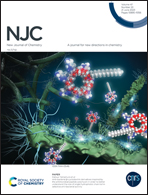Carbon nanotubes modified conductive ink for application to paper-based electrochemical biosensors for pathogenic DNA detection†
Abstract
We report the results of studies relating to the development of a conductive ink-coated, paper-based electrochemical DNA hybridization assay for the detection of the porA pseudogene of Neisseria gonorrhoeae (gonococcal DNA), the causative agent of gonorrhoea. Briefly, a conductive and highly homogenous ink was prepared by dispersing carboxylated MWCNTs (cMWCNTs) in a stable emulsion consisting of terpineol as solvent, carboxymethyl cellulose (CMC) as binder and polysorbate 80 (PS80) as the stabilizing agent. This cMWCNT-based ink was coated onto paper substrates to obtain cMWCNT@paper electrodes with a mean (± standard deviation, SD) resistivity of 1.066 (± 0.33) Ω cm. Furthermore, a magnetic bead (MB)-mediated hybridization assay comprising a specific 5′-biotinylated capture DNA probe (C) and 3′-methylene blue (MetB)-tagged detector DNA probe (D) was designed. These probes hybridized specifically with a porA target DNA sequence (T) forming a sandwich hybridization complex (C-T-D) at the MB surface. Thus formed C-T-D/Av/MB samples with different T concentrations were drop cast and adsorbed onto the cMWCNT@paper for electrochemical detection. The linear detection range and sensitivity of the electrochemical biosensing assay were found to be 100 fM–100 nM and 5.09 μA (log[concentration])−1, respectively. The biosensing assay was further shown to detect the target genomic gonococcal DNA in a mixture consisting of different DNA and protein interferents indicating its clinical viability. The results of rheological studies reveal that this thixotropic cMWCNT ink can be utilized for screen printing. These studies demonstrate the utilization of a conductive ink formulation for the fabrication of paper-based electrochemical sensing electrodes having high potential for cost-effective batch production and application in point-of-care (PoC) clinical diagnostics.



 Please wait while we load your content...
Please wait while we load your content...